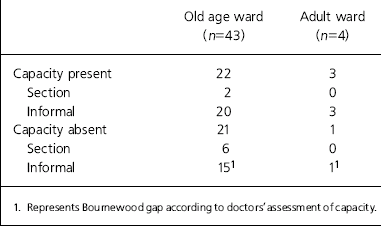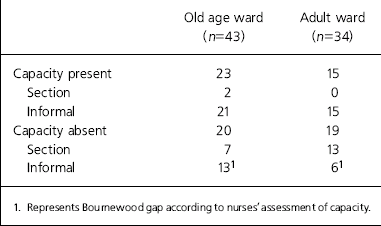Mental capacity is a legal concept related to the ability to enter into a valid contract. It is gained on entering adulthood and is presumed to be present throughout life unless demonstrated to be permanently or temporarily lost. To treat a capable patient without consent could be potentially an assault. In England and Wales, the Mental Capacity Act 2005 provides a statutory framework to protect vulnerable people who are not able to make their own decisions. The Act is underpinned by five key principles:
-
• a presumption of capacity
-
• the right for individuals to be supported to make their own decisions
-
• the right for individuals to make what might be seen as eccentric or unwise decisions
-
• anything done for or on behalf of people without capacity must be in their best interests
-
• the least restrictive intervention must be used.
The Act sets out a single clear test for assessing capacity which is both ‘decision specific’ and ‘time specific’. No one can be labelled ‘incapable’ simply as a result of a particular medical condition or diagnosis (Department of Health, 2005a ).
The Bournewood judgment
Many patients who do not have capacity to consent are given hospital treatment informally both in the medical and psychiatric setting (Reference Raymont, Bingley and BuchananRaymont et al, 2004; Reference Cairns, Maddock and BuchananCairns et al, 2005) and it is argued that their rights are not protected. Protecting the rights of in-patients with mental illness who lack capacity to consent was highlighted in England by the Bournewood case (L. v. Bournewood Community and Mental Health NHS Trust [1998]). A man with autism who lacked capacity was informally admitted to the Bournewood hospital. A Court found his admission illegal and ruled that he could be legally detained only if he were admitted formally under the Mental Health Act 1983. The Court of Appeal upheld this decision but the House of Lords overturned the judgment. However, Lord Steyn believed that the result was ‘an indefensible gap in our mental health law’ (House of Lords, 1998). The European Court of Human Rights later found his detention to be unlawful and concluded that he was deprived of his liberty contrary to article 5(1) and article 5(4) of the European Convention on Human Rights (H.L. v. UK [2004]).
In 2004, the Department of Health and National Assembly for Wales issued interim advice to the National Health Service (NHS) and local authorities for new procedural safeguards for the protection of those people falling into the ‘Bournewood gap’. This raised legal, ethical and workload issues for clinicians.
Method
Following the Department of Health's interim guidance, North Staffordshire Combined Healthcare NHS Trust (catchment population 460 000) introduced guidelines recommending that all in-patients should be assessed for mental capacity (to consent or object to hospital admission for an assessment and/or treatment) by nursing staff on admission and by a doctor within 72 h of admission. Locally a semi-structured form was designed for assessment and documentation of capacity for all admissions to the hospital. The semi-structured questionnaire was based upon the principles outlined in chapter 15 of the Mental Health Act Code of Practice (1999). Capacity, being a functional concept, was determined by the decision-making process, characterised by the person's ability to understand, retain and weigh up information relevant to the treatment decision in order to arrive at a choice, and then to communicate that choice. A negative response to any question defined incapacity. Staff did not receive formal training in the use of this questionnaire but guidance notes were provided.
We collected data from the case files of all acute in-patient admissions to general adult and old age wards on one census day. Results were analysed using SPSS Version 10.5 for Windows. We aimed to determine the point prevalence of mental incapacity in general adult and old age mental health in-patients at admission and to compare the reliability of capacity assessments made by nursing and by medical staff.
Results
There were 105 in-patients on the census day, 55 on old age wards and 50 on general adult wards. All patient personal details were completed on 85% of forms. Date of admission and the date of test were recorded on 99% and 85% of forms respectively. Capacity assessment forms were completed for 77 of the patients by nursing staff (43 in old age and 34 in general adult wards) and for 47 by doctors (43 in old age and 4 in general adult wards).
General adult wards
Doctors’ assessment of capacity could be traced for only 4 patients. Three of them had capacity. One who lacked capacity was being treated informally, falling into the Bournewood gap (nurses assessed 3 out of these 4 patients and they agreed with doctors in all cases). Table 1 shows that 6 (17.6%) patients fell into the Bournewood gap.
Old age wards
Out of 20 patients who lacked capacity on nurses’ assessment, 13 were treated informally. Among the 21 patients who lacked capacity on doctors’ assessment, 15 were treated informally. Thirty per cent of patients assessed by nurses fell into the Bournewood gap, as did 35% assessed by doctors (Tables 1 and 2).
Table 2. Capacity assessment by doctors (n=47)

| Old age ward (n=43) | Adult ward (n=4) | |
|---|---|---|
| Capacity present | 22 | 3 |
| Section | 2 | 0 |
| Informal | 20 | 3 |
| Capacity absent | 21 | 1 |
| Section | 6 | 0 |
| Informal | 15 1 | 1 1 |
1. Represents Bournewood gap according to doctors’ assessment of capacity
On old age wards fewer patients were treated using the Mental Health Act 1983 (‘sectioned’) when they lacked capacity (Tables 1 and 2).
Correlation of assessment of capacity
There were 43 patients who were assessed by both medical and nursing staff. There was a significant correlation between medical and nursing assessment of capacity (κ=0.719, P=0.0001).
Discussion
Our survey shows that a capacity assessment was rarely done by medical staff on general adult wards. On old age wards, more patients lacked capacity and the majority were treated informally. Our results are limited to one health district but nevertheless, in older adults, there was a high level of agreement between the two professional groups. Some of the disagreement may be related to the time gap between the two assessments (maximum 72 h). Capacity may fluctuate with time and the later assessment may be more accurate as it presumably is informed by extra information.
The UK literature is limited on the prevalence of mental incapacity among psychiatric in-patients. In a study by Cairns et al (Reference Cairns, Maddock and Buchanan2005), of 112 participants, 49 (44%) lacked treatment-related decisional capacity. Out of these, 30 were detained under the Mental Health Act 1983 and 19 (17%) fell into the Bournewood gap. Our study found 25% of patients to be formally detained, while between a third and a quarter of all in-patients were ‘Bournewood patients’.
The Mental Capacity Act 2005 came into effect in April 2007 in England and Wales. It includes independent mental capacity advocate (IMCA) services. National Health Service bodies and local authorities now have a duty to consult an IMCA in decisions involving incapacitated people who have no family or friends (Department of Health, 2006).
One interim recommendation was to use the 1983 Mental Health Act for passively compliant patients in order to give full access to their rights. In 1998, the Mental Health Act Commission undertook a survey (Department of Health, 2005) which implied that at any one point, there were some 22 000 compliant incapacitated hospital in-patients, who would instead have to be detained under the Mental Health Act. This would significantly increase the work pressure for responsible medical officers and mental health review tribunals.
Involving other professionals such as mental health nurses may ease the identification of such patients and potentially ease the administrative burden. This raises the question of how appropriate it will be to rely on nursing staff for capacity assessment, which is traditionally seen as a medical role. Historically consultants or responsible medical officers have taken responsibility for most clinical decisions, but practice is changing. New Ways of Working for Psychiatrists (Department of Health, 2005b ) highlights the changing context of service delivery and drivers for change. Psychiatrists and other members of the multidisciplinary team are exploring new ways to meet the needs of service users and their families. This work may show that staff may benefit from having greater clarity and focus in their roles. Capacity assessment by other mental health professionals may be seen as one of the new ways of working. In addition, the proposed new mental health act will replace the concept of responsible medical officer with that of a responsible clinician who may not be a doctor. So the decision on presence (or absence) of capacity may not be the sole responsibility of a doctor.
In conclusion, the prevalence of Bournewood gap patients was significant in our survey. These findings clearly emphasise the need for capacity assessment and its proper documentation. Our study also showed that nurses’ assessment of mental capacity correlates well with that of doctors. This preliminary observation suggests the possibility of shared responsibility with appropriately trained mental health nursing staff.
As Eastman & Peay (Reference Eastman and Peay1998) have discussed, capacity is set to become a major clinico-legal issue. Issues relating to capacity are contentious and can be subject to a high degree of medico-legal scrutiny. A clear, precise and legible record is therefore very important. The implications of this study may change the practice of capacity assessment and may be helpful in implementation of the new Capacity Act and Mental Health Bill 2006 in England and Wales.
Declaration of interest
None.






eLetters
No eLetters have been published for this article.